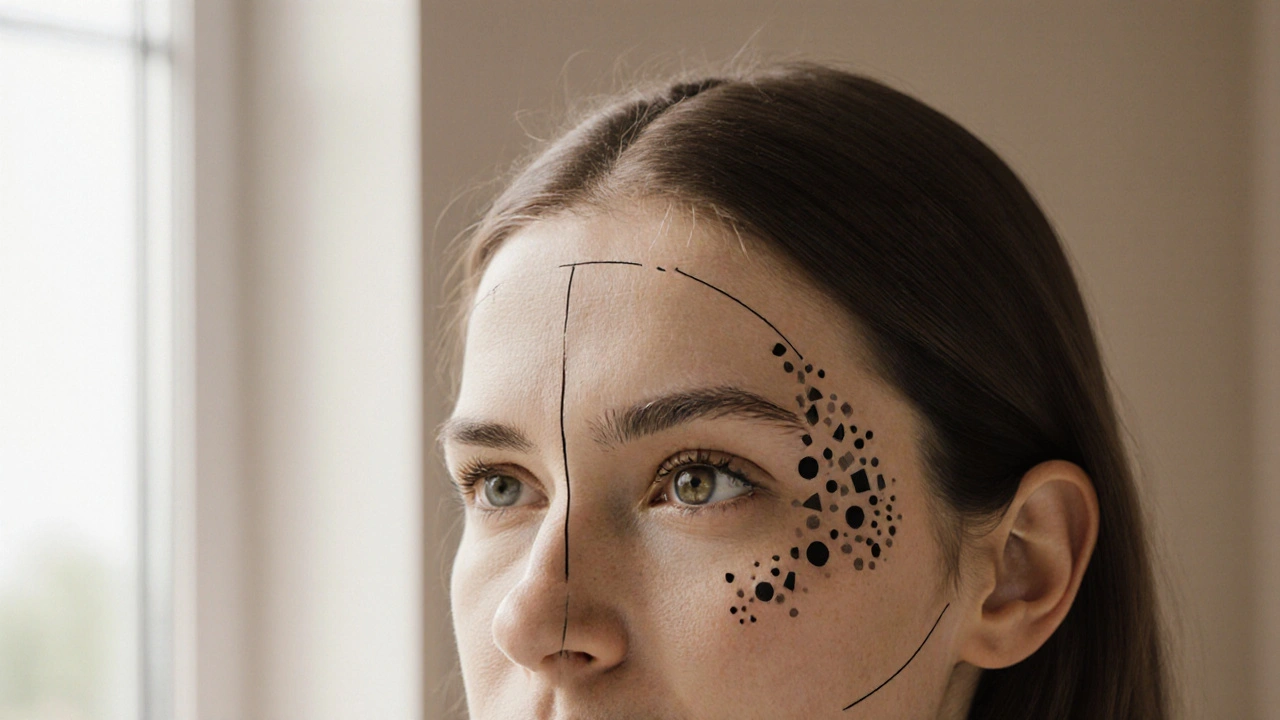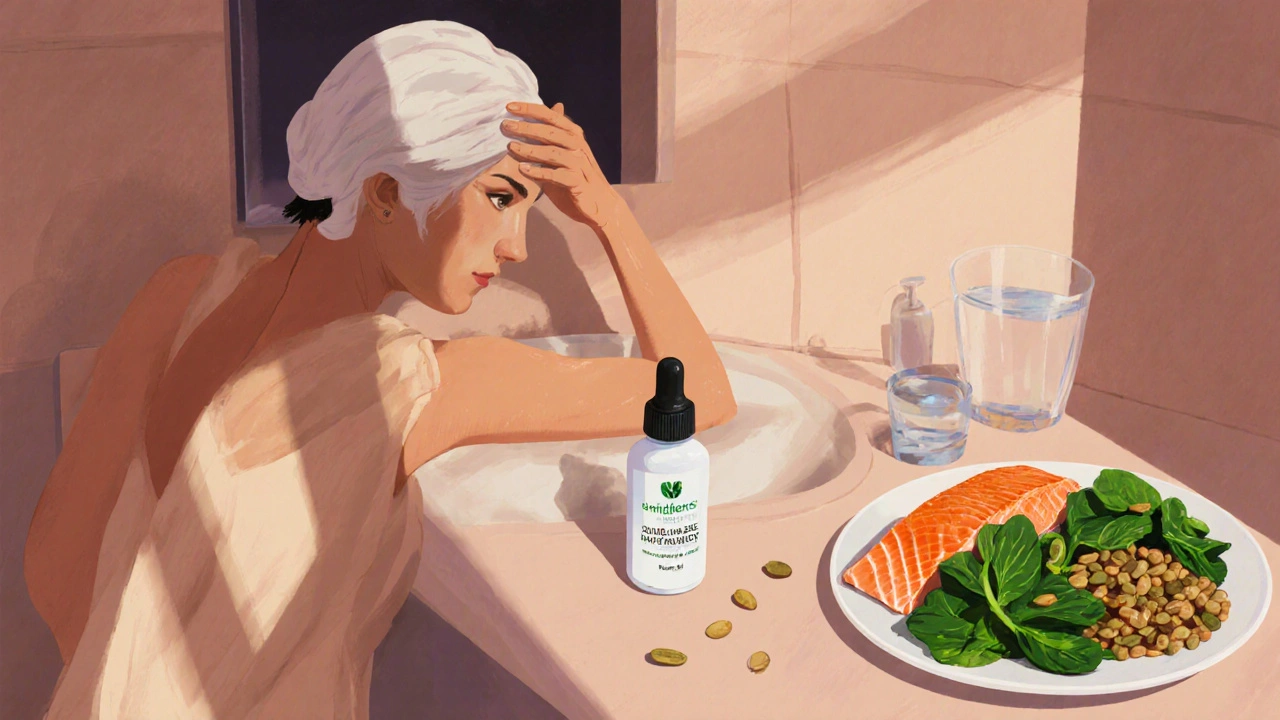
Alopecia Type Identifier
Answer the following questions to identify your type of alopecia and receive personalized care recommendations.
Your Alopecia Type
Recommended Care Steps
Key Takeaways
- Know which type of alopecia you have; treatment and styling differ.
- Gentle scalp hygiene and moisturizing prevent irritation and improve comfort.
- Nutrition rich in iron, zinc and biotin can support any remaining hair growth.
- Wigs, scarves, short cuts and scalp micropigmentation each solve different styling goals.
- Support groups and counseling help manage the emotional impact of hair loss.
Living with alopecia means learning a new routine for your scalp and your confidence. Below you’ll find a step‑by‑step guide that covers everything from daily care to styling choices, plus real‑world tips that actually work.
What Is Alopecia?
Alopecia is a medical condition that causes hair loss on the scalp, face or body. It isn’t a single disease; the umbrella term includes several sub‑types, each with its own pattern and triggers.
- Androgenetic alopecia - the most common hereditary form, often called male‑ or female‑pattern baldness.
- Alopecia areata - an autoimmune reaction that creates round, smooth patches.
- Traction alopecia - caused by constant pulling from tight hairstyles.
- Cicatricial (scarring) alopecia - permanent loss where scar tissue replaces hair follicles.
Understanding which type you have guides the choice of medical treatment (like minoxidil or steroids) and the styling solutions that look natural.

Daily Scalp Care Routine
Even when hair is thin or absent, the scalp needs the same care as any other skin surface. Follow these steps each day or every other day depending on your scalp’s oiliness.
- Gentle cleansing: Use a sulfate‑free shampoo formulated for sensitive scalps. Look for ingredients like aloe vera, chamomile or oatmeal. Massage the scalp with fingertips-don’t scrub with nails.
- Condition wisely: If you still have some hair, apply a light conditioner only to the ends. For a completely bald scalp, skip conditioner and move to the next step.
- Moisturize: After washing, dampen the scalp and apply a thin layer of a fragrance‑free, silicone‑free scalp serum (e.g., a hyaluronic acid or glycerin base). This locks in moisture and reduces itch.
- Sun protection: The scalp can burn just like any other skin. Use a spray‑on sunscreen or wear a hat when outdoors for more than 30 minutes.
- Scalp massage: 2-3 minutes of gentle circular motions boosts blood flow, which can help any remaining follicles thrive.
Nutrition & Lifestyle Factors
Hair is made of keratin, a protein that needs a steady supply of nutrients. While no diet can reverse scarring alopecia, a balanced plate can improve overall scalp health.
- Iron: Deficiency is a leading cause of diffuse hair shedding. Include lean red meat, lentils, spinach and fortified cereals. Aim for 18mg/day for women, 8mg/day for men.
- Zinc: Supports DNA synthesis in hair follicles. Sources: pumpkin seeds, oysters, chickpeas.
- Biotin (VitaminB7): Often touted for hair growth. A daily 30µg supplement is safe for most adults.
- VitaminD: Low levels correlate with alopecia areata severity. Get 600-800IU from sunlight or fortified foods; supplement if blood test shows deficiency.
- Omega‑3 fatty acids: Anti‑inflammatory, found in salmon, walnuts, flaxseed oil.
Stay hydrated (2‑3L water a day) and manage stress through yoga, meditation or regular exercise-stress spikes can trigger alopecia areata flare‑ups.
Styling Options That Work
Choosing the right look depends on your comfort level, budget and how much time you want to spend each morning. Below is a quick comparison of the most popular routes.
| Option | Cost (initial) | Maintenance | Natural Look | Best For |
|---|---|---|---|---|
| Short haircut (pixie, buzz) | £30‑£70 salon | Low - trim every 4‑6weeks | Very high - uses your own hair | Those who want minimal daily effort |
| Wig (synthetic or human‑hair) | £100‑£500 | Medium - wash & restyle weekly | High - especially human‑hair options | Full coverage, special occasions, confidence boost |
| Scarf / headwrap | £10‑£40 | Very low - wash as needed | Moderate - depends on fabric and style | Casual, cultural expression, quick changes |
| Scalp Micropigmentation | £700‑£1500 | Low - occasional touch‑up every 2‑3years | Very high - mimics shaved scalp | Permanent look, no daily upkeep |
Short Cuts: Embrace the Natural Edge
A low‑maintenance style works well once the hair density is low enough to blend with the scalp. Ask your dermatologist or trusted barber to keep the length even and shape the front to soften any visible bald spots.
Wigs & Hairpieces
Wigs have come a long way. Modern synthetic fibers can look almost indistinguishable from natural hair, and human‑hair options can be dyed, curled or straightened. Key points to consider:
- Cap construction: Lace front gives the illusion of a hairline; monofilament caps add breathability.
- Attachment: Clip‑on for occasional wear, adhesive for all‑day security.
- Care routine: Use a wig‑specific shampoo, avoid regular heat tools unless the wig is heat‑resistant.
Even if you’re on a budget, many charities and support groups offer gently‑used wigs at reduced cost.
Scarves, Turbans & Headwraps
Fabric accessories are perfect for a quick, stylish change. Choose breathable, natural fibers like cotton, silk or bamboo to avoid scalp sweating. Tie‑techniques vary by culture-learn a few from YouTube tutorials to keep things fresh.
Scalp Micropigmentation (SMP)
SMP is a cosmetic tattoo that deposits tiny pigment dots onto the scalp, mimicking the appearance of shaved hair follicles. It’s a permanent solution that works best after hair loss stabilizes. Find a certified practitioner; a typical session lasts 2‑3hours and may require 2‑3 appointments for full coverage.

Product Recommendations (Micro‑tested)
Below are three products that consistently get good feedback from people managing alopecia.
- Gentle Scalp Cleanser - a sulfate‑free, pH‑balanced shampoo with oat extract. Ideal for daily use.
- Hydrating Scalp Serum - contains hyaluronic acid, panthenol and tea tree oil to soothe irritation without greasiness.
- Lightweight Hair Fiber Powder - if you have sparse patches, a keratin‑based fiber can be dusted on for a temporary fill‑in effect.
Emotional Well‑Being & Community Support
Alopecia can feel isolating, especially when you’re used to a full head of hair. Here are practical ways to stay positive:
- Support groups: Online forums (e.g., Alopecia UK, Reddit’s r/AlopeciaAreata) let you share experiences and styling ideas.
- Counseling: Talking to a therapist who specializes in body image can reduce anxiety.
- Storytelling: Documenting your journey on a personal blog or Instagram can turn a challenge into inspiration for others.
Remember, confidence comes from how you carry yourself, not just from hair.
Frequently Asked Questions
Can I still use minoxidil if I have alopecia areata?
Minoxidil can help stimulate any remaining follicles, but it doesn’t address the autoimmune attack behind alopecia areata. It’s best used alongside a dermatologist‑prescribed steroid or immunotherapy.
How often should I wash a wig?
Most synthetic wigs need a gentle wash every 10‑14days. Human‑hair wigs can be washed every 1‑2weeks, using a specially formulated wig shampoo.
Is scalp micropigmentation painful?
The sensation is similar to a light tattoo. A topical anesthetic is usually applied, making the procedure tolerable for most clients.
What foods should I avoid to reduce hair shedding?
Highly processed foods, excess sugar and trans‑fats can increase inflammation, which may worsen alopecia. Focus on whole, nutrient‑dense meals instead.
Can I wear hats if I have a wig?
Yes, but choose loose‑fitting hats to avoid crushing the wig fibers. A silk or satin liner can reduce friction and keep the wig looking fresh.
Managing alopecia isn’t a one‑size‑fits‑all plan. By mixing sensible scalp care, smart nutrition, and the styling tools that make you feel good, you can turn hair loss into a confident new look. Start with one small change today-whether it’s a gentler shampoo or a cozy headscarf-and watch how quickly your outlook improves.






Summer Medina
October 8, 2025 AT 22:45Alopecia is not just a cosmetic issue it is a daily battle with your scalp and confidence. The guide tries to cover everything but it still misses the nuance of real life struggle. First you need to stop treating your scalp like a neglected garden and start giving it proper care. A sulfate free shampoo is essential because harsh detergents can strip natural oils and cause itching. Follow up with a fragrance free serum that contains hyaluronic acid to keep the skin hydrated. Never underestimate the power of a gentle scalp massage it improves blood flow and reduces stress. Nutrition plays a huge role iron zinc biotin and vitamin d are not optional they are required for any hair follicle activity. If you suspect a deficiency get a blood test and supplement accordingly under medical supervision. When it comes to styling avoid tight ponytails braids or anything that pulls on the hairline because traction alopecia can become permanent. Loose buns half up styles are a safe alternative that let you feel normal without damage. Wigs have improved dramatically in the last decade synthetic fibers can now mimic natural shine. Human hair wigs are still the gold standard but they need proper cleaning with wig specific shampoo. Scalp micropigmentation offers a permanent solution for those who want a shaved look without daily maintenance. Support groups are invaluable they provide emotional backup and practical tips you wont find in articles. Remember confidence comes from how you carry yourself not from the amount of hair on your head. Keep experimenting with small changes each week and you will notice a shift in both comfort and self esteem.
Joshua Brown
October 9, 2025 AT 20:25One of the most effective daily practices, in my experience, starts with a gentle cleanse; choose a sulfate‑free shampoo, that way you avoid stripping natural oils, and then follow with a lightweight, fragrance‑free serum, which helps to retain moisture. After washing, lightly pat the scalp dry with a soft towel-no rough rubbing-because friction can increase irritation. Applying a silicone‑free moisturizer within the first five minutes helps to lock in hydration; you’ll notice less itchiness and a smoother feel. Sun protection is also crucial; a spray‑on SPF or a wide‑brimmed hat shields the scalp from UV damage, which can exacerbate inflammation. Finally, incorporate a brief scalp massage-two to three minutes-in a circular motion; this promotes blood circulation and can support any remaining follicles. Remember to stay consistent, as benefits accrue over weeks, not days.
andrew bigdick
October 10, 2025 AT 18:05Hey folks, just wanted to drop a quick inclusive tip: if you’re juggling diet changes with scalp care, aim for a balanced plate that includes lean proteins, leafy greens, and omega‑3 rich foods like salmon or walnuts. Those nutrients give the follicles the building blocks they need while also keeping inflammation in check. Also, don’t feel pressured to jump straight into a wig-sometimes a simple, breathable headwrap can boost confidence while you’re figuring out what works best for you.
Shelby Wright
October 11, 2025 AT 15:45Whoa, hold up-if you think a quick headwrap is the holy grail, think again! The guide glosses over the fact that many people feel the social sting of staring eyes, and a flimsy scarf just isn’t cutting it in a professional setting. You need bold moves, maybe a statement wig that screams confidence, not a timid towel. Otherwise you’re just playing dress‑up and ignoring the deeper emotional battle.
Ryan Wilson
October 12, 2025 AT 13:25From a moral standpoint, it’s essential to recognize that ignoring scalp health is tantamount to neglecting personal responsibility. If you’re casually tossing harsh chemicals onto your head, you’re basically signing a contract with future hair loss. The community deserves better than half‑hearted advice; we must champion evidence‑based treatments and reject gimmicks that prey on vulnerable individuals.
EDDY RODRIGUEZ
October 13, 2025 AT 11:05Absolutely, taking ownership of your scalp care is a powerful step forward! Start by swapping out any sulfates for a mild cleanser, then a calming serum-think aloe or tea tree-can really soothe irritation. Pair that with a balanced diet rich in iron and zinc, and you’ll see both the scalp’s comfort and confidence rise. Keep at it daily; consistency is the key that turns small actions into big results.
Christopher Pichler
October 14, 2025 AT 08:45Let’s break down the core components: a scalp‑centric routine should incorporate a pH‑balanced cleanser, a barrier‑repair emollient, and periodic photobiomodulation if accessible-though the latter is still under investigation. In practice, the marginal gains from each module stack, yielding a synergistic effect on follicular health. That said, the ROI on high‑tech devices is still debatable, so prioritize fundamentals first.
VARUN ELATTUVALAPPIL
October 15, 2025 AT 06:25To add to the technical perspective, consider integrating a low‑level laser therapy device-ensure it operates at 650‑670 nm wavelength, at least 5 minutes per session, three times weekly; users report modest improvements in mini‑density; however, rigorous double‑blind studies remain scarce; always consult a dermatologist before adding such modalities.
April Conley
October 16, 2025 AT 04:05Culture shapes how we view hair loss; in many societies, embracing a bald look is a sign of wisdom, so don’t feel pressured to hide it. Choose accessories that honor your heritage while protecting your scalp.
Sophie Rabey
October 17, 2025 AT 01:45Sure, the guide is solid-but let’s be real, most of us will still spend hours scrolling for the perfect wig that doesn’t look like a costume. At least the list of options gives you a starting point, even if you end up buying three before finding the right vibe.
Bruce Heintz
October 17, 2025 AT 23:25Great points! 😊 Remember, you’re not alone in this journey-lean on community forums, share your progress, and celebrate small wins. Together we can make the path less lonely.
richard king
October 18, 2025 AT 21:05In the grand tapestry of existence, hair is but a fleeting filament, yet its absence can echo louder than any thunderclap; thus we must seek meaning beyond the visible, embracing inner light as the true source of confidence.
Dalton Hackett
October 19, 2025 AT 18:45Okay, so first off, the article gives a decent framework but there are a few glaring gaps that need addressing. The section on scalp cleansing mentions a sulfate‑free shampoo but fails to specify why sulfates are problematic-it’s not just about “harsh chemicals,” they actually strip the lipid barrier, leading to dryness and potential inflammation, especially for those with sensitive skin. Also, the recommendation to use a hyaluronic acid serum is solid, yet there’s no guidance on concentration; a 0.5% solution works for most, whereas higher percentages can feel sticky and may not be well‑tolerated. Moving on to nutrition, the list includes iron, zinc, biotin, vitamin D, and omega‑3s, which is comprehensive, but the article neglects to mention the importance of balanced calcium and magnesium intake, both of which play a role in hair follicle cycling. Another oversight: while the piece briefly touches on wigs, it doesn’t discuss the difference between monofilament and lace‑front caps, which can affect breathability and the natural appearance of the hairline-a crucial factor for many users. Lastly, the emotional well‑being section suggests support groups, but it could be expanded with specific resources such as the Alopecia Areata Foundation or the International Alopecia Foundation, providing readers direct avenues for connection. Overall, the article is a solid starter, but adding these details would transform it from a generic guide into a truly actionable roadmap.
Lila Tyas
October 20, 2025 AT 16:25Hey team! Let’s keep the momentum going-start today with a quick scalp massage and a dash of that hydrating serum. You’ll feel the difference in just a few minutes, trust me!
Mark Szwarc
October 21, 2025 AT 14:05Good advice all around. To add a practical tip: when using a wig, store it on a mannequin head or a wig stand to preserve its shape and reduce tangling. Also, a small amount of dry shampoo between washes can keep it fresh without over‑washing. Consistency in care will prolong the wig’s lifespan and keep you looking sharp.
BLAKE LUND
October 22, 2025 AT 11:45While the guide’s suggestions are solid, remember that personal style is a cultural expression-pick accessories that reflect your background, and you’ll feel more authentic in the process.
Veronica Rodriguez
October 23, 2025 AT 09:25Thanks for the thorough guide! 😊
Holly Hayes
October 24, 2025 AT 07:05Honestly, the article feels a bit too mainstream, as if it were written for a mass‑market beauty blog rather than for people dealing with real, complex alopecia challenges.
Matthew Shapiro
October 25, 2025 AT 04:45The information presented is comprehensive and well‑structured, offering a balanced perspective on both medical and styling aspects of alopecia management.